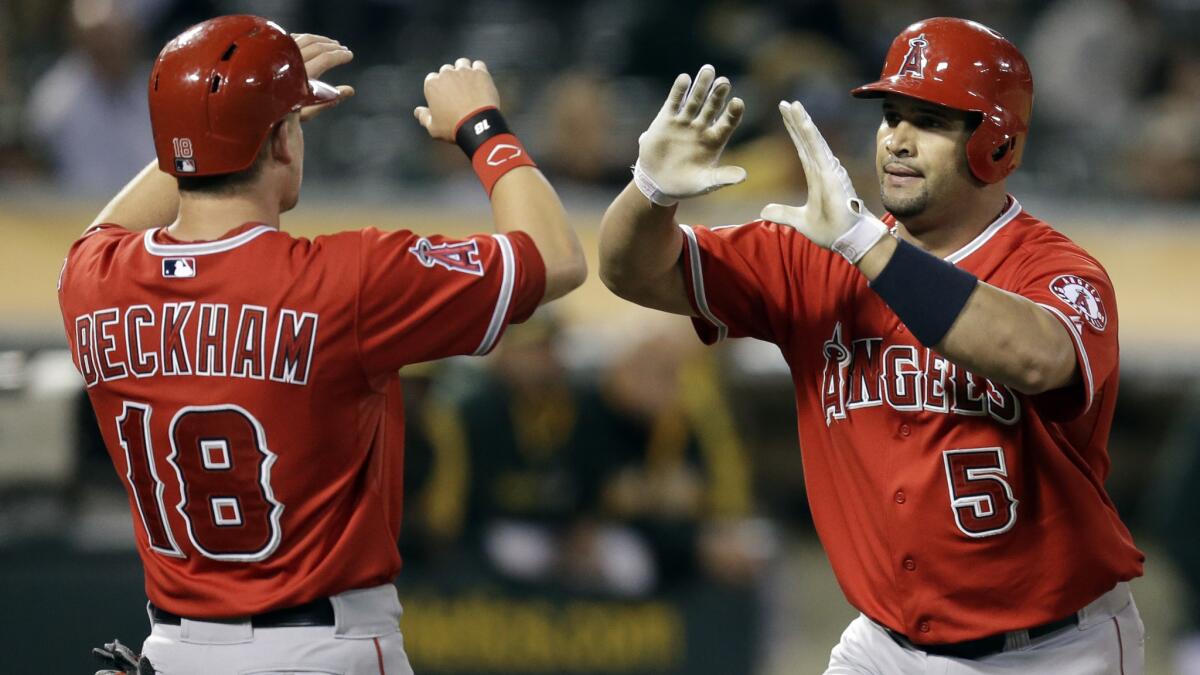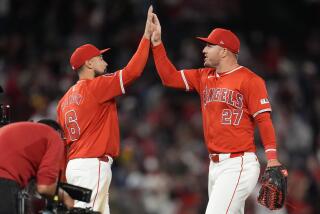Angels may have turned back the clock

- Share via
It first struck Tim Salmon in early July, when the Angels steamrollered the Texas Rangers in a four-game sweep. It became more apparent July 18, when the Angels traded for proven closer Huston Street, turning a much-improved bullpen into a dominant one.
It was solidified in early September, when the Angels’ offense went off, averaging almost nine runs a game during a 10-game win streak that sealed the American League West title.
“This team is really reminiscent of our 2002 team,” said Salmon, the right fielder on the club that mashed its way to the World Series championship that October. “They’re putting up a lot of runs, and they’re getting great pitching from their bullpen. Hopefully, the postseason for them goes like it did for us.”
The Angels open the AL division series against the Kansas City Royals on Thursday, and despite their major league-best 98-64 record, they may have the thinnest and least-imposing rotation of the eight playoff participants.
Game 1 starter Jered Weaver is a veteran right-hander who consistently pitches into the seventh inning and gives the Angels a chance to win.
But left-handers C.J. Wilson and Hector Santiago were erratic in September, their occasional brilliance offset by some early blowouts, and right-hander Matt Shoemaker will be trying to pitch through a potentially painful rib-cage strain.
The Angels survived — even thrived — after losing their best pitcher, Garrett Richards, to a knee injury Aug. 20. The loss of the right-hander could sting more in October, as the Angels match up against some shut-down starters.
But the Angels don’t have to look far for proof you can win a World Series without dominant starting pitching. Their blueprint for success is a virtual carbon copy of the 2002 team’s: Get a lead or stay even through five innings, hand the ball to the bullpen and enjoy the ride.
And if the starter struggles? Then pummel the opposing pitcher.
“You can bet it’s going to be a race to the fifth inning for [Manager Mike] Scioscia unless he’s got Weav out there,” said Troy Percival, the closer on the 2002 club. “When you have the bullpen the Angels have, it becomes a five-inning game. It’s similar to when we were rolling in 2002. We could cover four innings every day on a playoff run.”
The 2002 rotation featured Jarrod Washburn, an ordinary left-hander who had an extraordinary 18-6 season, aging veteran Kevin Appier, volatile Ramon Ortiz and rookie John Lackey.
That group went 5-3 with a 5.38 earned-run average and delivered two quality starts in 16 playoff games, averaging a shade over five innings a start.
But the relievers went 6-2 with a 4.07 ERA, and the back of the bullpen — Percival, Brendan Donnelly and 20-year-old phenom Francisco Rodriguez — had a 2.76 ERA in 42 1/3 innings and gave up four runs in 18 2/3 innings (1.93 ERA) of a seven-game World Series against San Francisco.
The current relief corps is not as dominant but is effective and deep, with veteran right-handers Joe Smith, Kevin Jepsen and Jason Grilli setting up Street, and Fernando Salas and rookie Mike Morin providing middle-inning support.
“We had a once-in-a-lifetime bullpen,” Salmon said. “But these guys are more than capable of pitching lights out for an inning.”
Scioscia credits the bullpen’s ability to hold leads — relievers combined for a 2.94 ERA in the last 90 games — as the primary reason for the team’s midseason surge. And with off days built into the playoffs, Scioscia can use his front-line relievers in every game.
“They’re all right-handers who can get left-handers out, and they pitch without fear — it’s a very similar bullpen in that way,” Percival said. “They pound the strike zone and challenge hitters.”
The 2002 team had a deep and relentless lineup that averaged 6.3 runs a game in the postseason, batting .320 with 24 homers and 30 doubles. It broke out for an eight-run inning in the division series against New York and a 10-run inning in the championship series against Minnesota.
Salmon and Percival see similar potential in the current lineup, which is headed by gritty leadoff man Kole Calhoun, the dynamic Mike Trout and rejuvenated slugger Albert Pujols.
Howie Kendrick and Erick Aybar provide steady middle-of-the order production, David Freese got hot in September, Chris Iannetta is an on-base machine, and Josh Hamilton could add punch if he finds his stroke after an injury-plagued September.
The Angels, who led the major leagues with 773 runs and 45 comeback wins, have power and speed. They run the bases aggressively. They find ways to beat top-flight pitching. And, like the 2002 team, they seem to feed off each other.
“Hitting breeds hitting, and we got hot and threw up some big numbers,” Salmon said. “I’ve seen that from this offense. They’ll get those innings where they score three, four, five runs, and those can totally derail the morale of an opponent. The offense can be the difference-maker, and it’s not just Trout. Several guys can carry that load.”
The 2002 lineup featured the feisty David Eckstein and Darin Erstad up top and Garret Anderson, Salmon and Troy Glaus in the middle. Brad Fullmer, Scott Spiezio, Bengie Molina and Adam Kennedy added depth.
Situational hitting was a strength of that team, which executed hit-and-run plays, got bunts down and advanced runners from first to third on singles better than any Scioscia club.
“They refused to give up an at-bat, one through nine, and I see the Angels doing that now,” Percival said. “They’re playing a hard-nosed game, taking extra bases, playing together.
“That’s one of the biggest similarities with our club; they’re playing as a team, top to bottom. I don’t see any selfish at-bats, I don’t see anyone playing for their own numbers. That’s the one thing that’s been missing in the last eight to 10 years.”
Twitter: @MikeDiGiovanna
More to Read
Go beyond the scoreboard
Get the latest on L.A.'s teams in the daily Sports Report newsletter.
You may occasionally receive promotional content from the Los Angeles Times.







